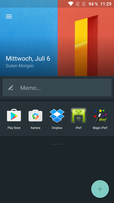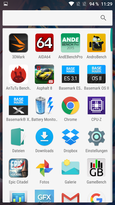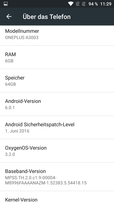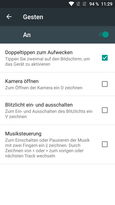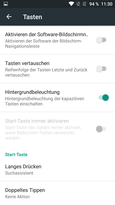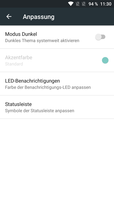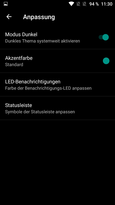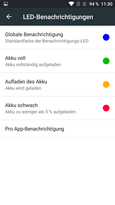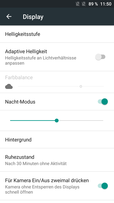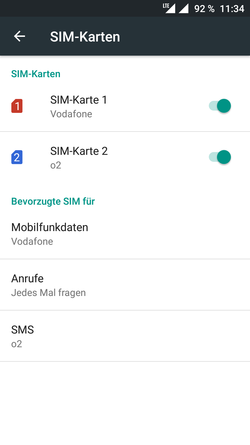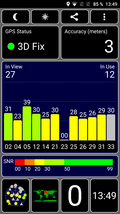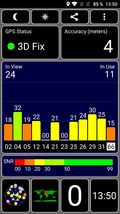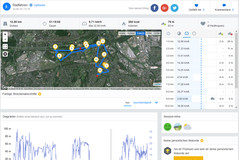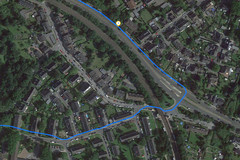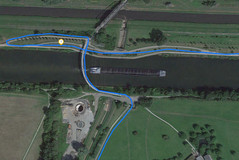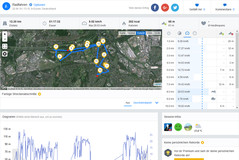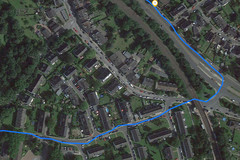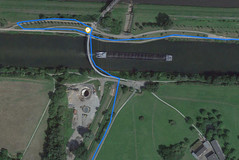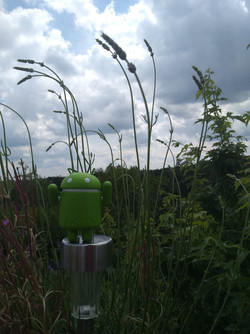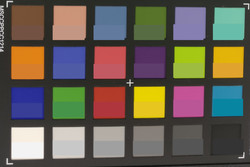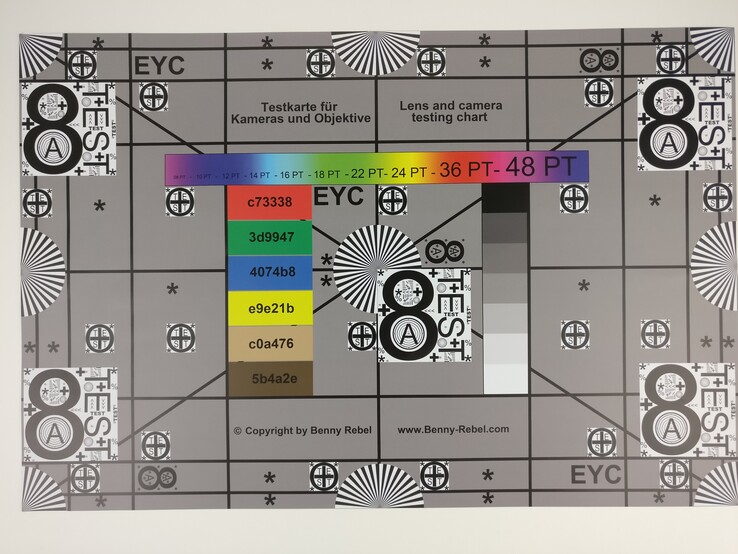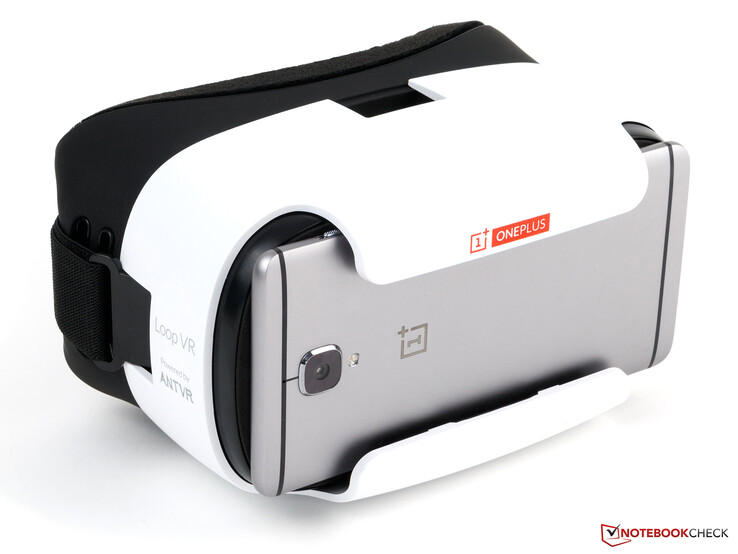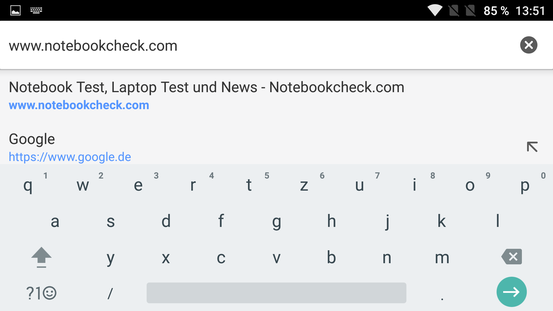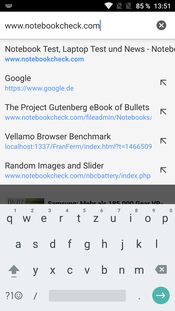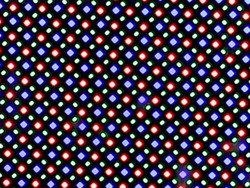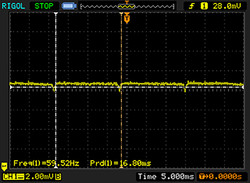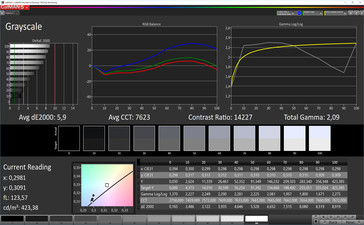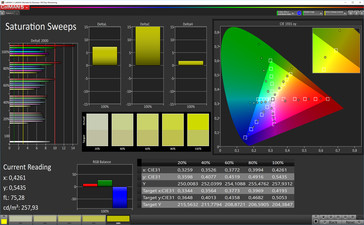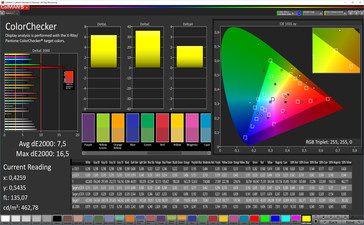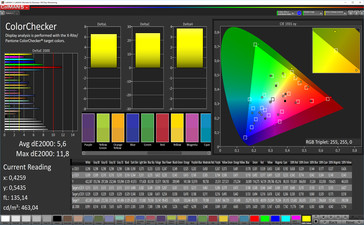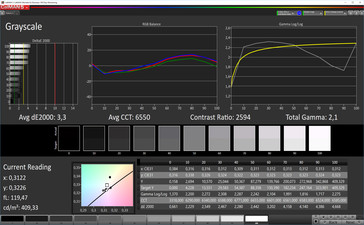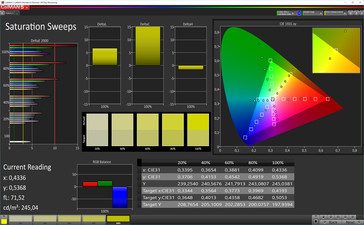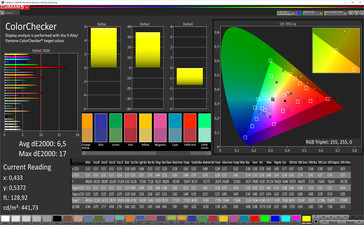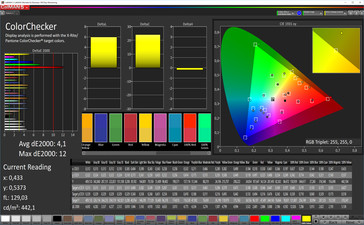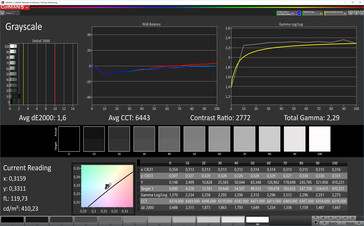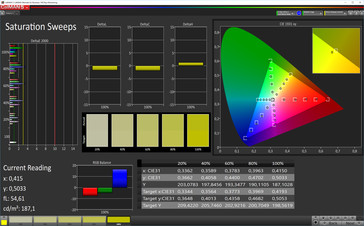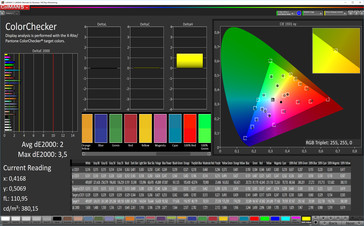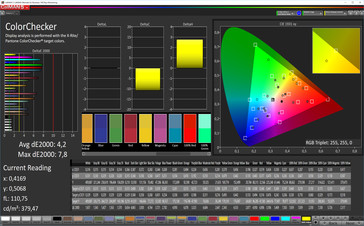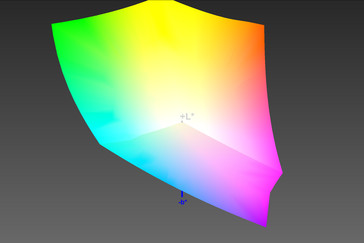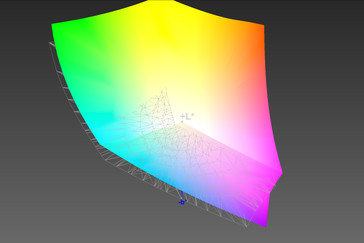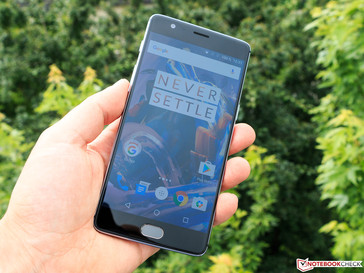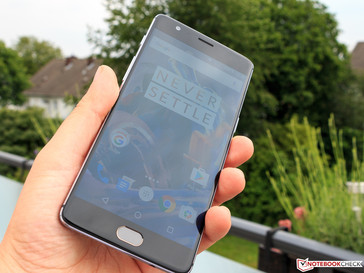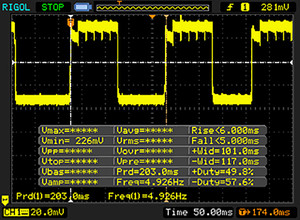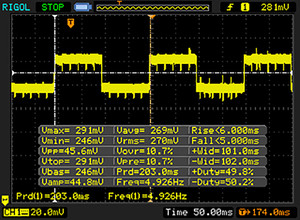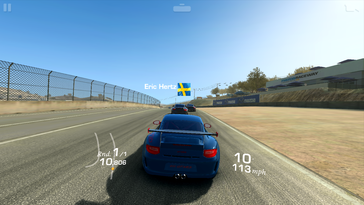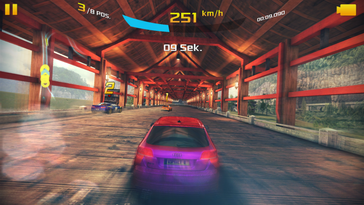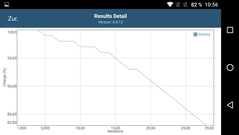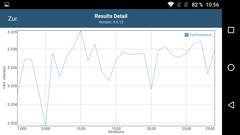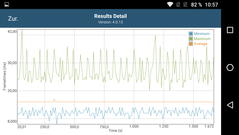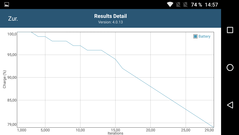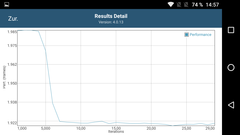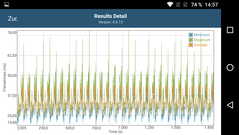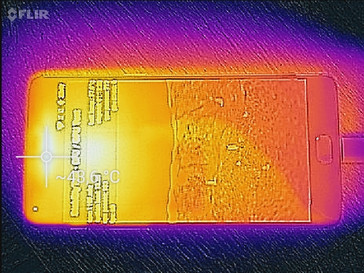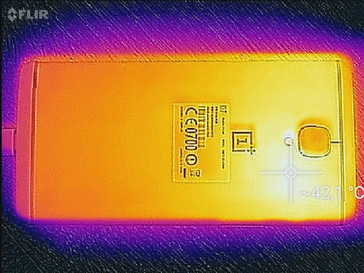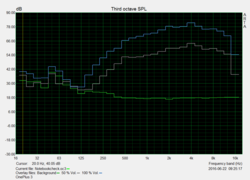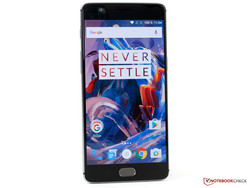OnePlus 3 Smartphone Review
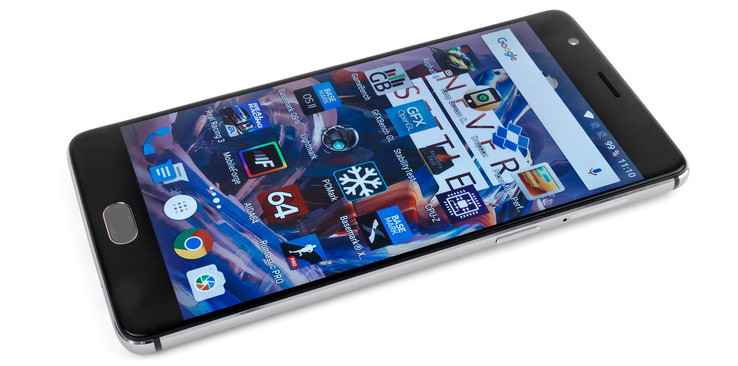
For the original German review, see here.
Three follows two, and thus the name of the new flagship killer is not surprising. The OnePlus 3 is the successor of the OnePlus 2. The looks have not changed much. OnePlus has cast off the sanded rear side and now uses an aluminum unibody case. Inside, the current Snapdragon 820 ensures fast performance. 6 GB of RAM is an enormous capacity, but the future will show if this is really necessary. The internal storage of 64 GB cannot be expanded. On the other hand, a dual SIM slot is present. A 16 MP rear camera and an 8 MP front camera are suitable for this category - at least on paper.
The screen has similar specifications as its predecessor: A diagonal of 5.5 inches and a resolution of 1920x1080 pixels. As the OnePlus 3 also is designed for using VR content, we would have wished for a QHD panel. OnePlus no longer uses the IPS technology, but incorporates an AMOLED screen. Finally, the OnePlus 3 now comes with NFC.
All devices of distinction can be used for comparison. Although the opponents are considerably more expensive, OnePlus aims to challenge just this sector. Thus, smartphones such as Samsung's Galaxy S7 Edge, Apple's iPhone 6s Plus, Huawei's P9, P9's Plus, Google's Nexus 6P, Sony's Xperia Z5 Premium, the Moto X Force, HTC's 10, LG G5, ZTE's Axon 7, Xiaomi's Mi 5, and Microsoft's Lumia 950 XL count as rivals.
Case
Compared with the predecessor, the casing of the OnePlus 3 has been revamped. The manufacturer now relies on an aluminum unibody that looks like that of HTC's 10 or Huawei's Mate S. With just 7.35 millimeters (~0.3 in) in height, the smartphone is noticeably slimmer. We measured 6.8 to 7.8 millimeters (~0.27 to 0.31 in) depending on the position. The camera juts out by approximately one millimeter (~0.04 in).
At 178 grams (~6.3 oz), the newer model has gained some weight. This is not a problem in everyday use, and conveys a certain degree of quality. It is a shame that OnePlus has discarded the sandstone-like back. However, it is possible to refit it with an optionally available cover.
The build is of a high standard. The manufacturer does not slip up anywhere here. The gaps are completely even and the SIM tray also closes flush with the rest of the casing. The body is quite twist-resistant and does not make a noise despite several warping attempts. Generally, wave formations do not appear on the screen thanks to the underlying OLED technology.
Up to two nano-SIM cards can be inserted in the card tray. Once again, expanding the storage of the OnePlus 3 via a micro-SD card is not possible. The battery is non-removable, making it impossible for the user to replace it.
Connectivity
The connectivity of the OnePlus 3 is up-to-date. Although it offers only one USB 2.0 port, at least it is the current Type-C format. OTG is also supported, making it possible to connect external storage devices and peripherals. However, this feature has to be enabled first in the settings.
Wireless mirroring of video contents on external monitors is possible via Miracast. This functioned very well in conjunction with a Fire TV stick. Only while rendering a Full HD video did we experience occasional micro-stutters.
Once again, a multi-colored notification LED is present. It can be configured extensively. For example, the battery states and various apps can be given different colors. Alternatively, the screen can be awakened from standby for notifications.
In addition to the latest Bluetooth 4.2 standard, OnePlus has finally incorporated NFC into its flagship. The notification slider familiar from the OnePlus 2 is also installed. However, the user will not find an infrared transmitter or a radio receiver.
Software
The review sample was still based on OxygenOS 3.1.2 when we started our tests. It was updated to version 3.2.0 in the course of the test. OnePlus' operating system is based on Android 6.0.1 Marshmallow and looks like the normal stock standard Android. The manufacturer has not made any major feature updates compared with to the OnePlus' 2.
Once again, Shelf again adds an additional page on the start screen, and displays weather, favorite contacts and recently used apps. The known familiar features like such as a dark theme and extended app manager are also again present.
The focus of the latest version is to resolve the initially observed storage management issues. We did not notice any problems during the test.
Communication & GPS
The OnePlus 3 is suitably equipped in terms of communication. Mobile Internet is accessed via quad-band HSPA or LTE Cat.6. Unfortunately, it does not offer any of the newer standards, and there are now regional differences in the supported bands. For example, the European and Asian models support three TDD LTE bands. They are not available in the North American version that, however, supports bands 12 and 17, but not band 20 which is important in Europe. The OnePlus 3 is no longer a genuine Globetrotter.
On the other hand, it is great that the smartphone is only available as a dual-SIM handset and both slots support the fast LTE standard. We did not experience any reception issues in an urban area with the OnePlus 3.
The smartphone's Wi-Fi module supports the latest IEEE 802.11 a/b/g/n and ac standards, which allows transmission in both the 2.4 and 5.0 GHz frequency ranges. We still had a good connection quality and low signal attenuation (-64 dBm) even approximately 10 meters (~33 ft) away from the router. Limitations while browsing or streaming videos were not observed. We also measured the Wi-Fi transmission speed between the smartphone and our Linksys EA 8500 reference router. The OnePlus 3 is only defeated by Samsung's Galaxy S7 Edge. The data rates during the test were stable and there were no significant fluctuations.
| Networking | |
| iperf Server (receive) TCP 1 m | |
| Samsung Galaxy S7 Edge | |
| OnePlus 3 | |
| Huawei P9 | |
| iperf Client (transmit) TCP 1 m | |
| Samsung Galaxy S7 Edge | |
| OnePlus 3 | |
| Huawei P9 | |
The OnePlus 3 utilizes the GPS, GLONASS and BeiDou for localization. Tracking is accurate to 5 to 6 meters (~16 to 20 ft) indoors and improves to 3 to 4 meters (~10 to 13 ft) outdoors.
To test real-world suitability, we took the smartphone on a bike ride along with Garmin's Edge 500. The recorded distances are virtually identical. Only when looking at the detailed routing, it is seen that the OnePlus 3 does not refresh its location quite as frequently as the GPS computer, and thus inaccuracies appear primarily in difficult places such as in the area of the bridge. Nevertheless, its performance is more than sufficient for navigating.
Telephone & Call Quality
The phone app of the OnePlus 3 corresponds to the Android standard. Users who are familiar with the operating system from other smartphones will cope easily here.
The call quality of the OnePlus 3 is good when holding the handset to the ear. We always understood our contact very clearly and without any static. We sounded rather tinny at the other end, and some minor noise accompanied our voice. Oddly, it disappears when noise cancellation is enabled. This functioned very reliably and filtered out loud background music almost completely during the test.
Phoning via the speaker did not appeal to us as much. The contact's voice echoes slightly, and the voice of the OnePlus 3 user is transmitted with recurrent, brief interruptions.
Cameras
The cameras on both sides of the OnePlus 3 have been upgraded. An 8 MP lens with only a fixed focus is now installed on the front. The photos are quite good, but they could be slightly brighter. A Beauty mode helps to boost selfies. Although soft-focus is relatively subtle, it also brightens up the skin when its setting is increased.
Three megapixels have been added to the rear-facing camera, and it now shoots photos with up to 16 MP (4.3; 4640x3480 pixels). The aperture has not been modified, but the specified f/2.0 also promises good light sensitivity. The laser auto focus has had to make way for a phase detection auto focus, which is to be more reliable, especially at greater distances to the object. The focus system proved to be fast and reliable in everyday use.
The photo quality varies to quite some degree. It lacks a bit of dynamic and the leaves in the front look rather faded in ambient photos (scene 1). The Galaxy S7 Edge in particular does a much better job here. However, the OnePlus 3 delivers a better image in the woods scene; the strongly lit outlines of the trees do not fray as much as in photos taken with the rivals. The review sample is on par with the iPhone 6s Plus in night shots, but it cannot compete with the S7.
The OnePlus 3 records videos in Ultra HD (42 MBit/s) at up to 30 frames per second. Thus, it has an edge on rivals such as Huawei's P9 Plus that does not support the modern standard. The frames are recorded impeccably, and the auto focus adapts well to the image. Unfortunately, UHD recordings are limited to 10 minutes, and the sound could also be better.
We photographed both ColorChecker Passport and our test chart as full-frame as possible in controlled light conditions. Looking at ColorChecker it is evident that the photos are slightly too warm and more saturated. Although this is not natural, it looks good. Users who do not like this can select from among four color temperature settings in manual mode, and also let the image look cooler. However, generally manual mode offers a few more settings.
The photo of our test chart reveals some minor weaknesses. For example, the lines are not completely straight, even in the center of the image. Dark letters on dark surfaces also fray a bit. The sharpness decreases slightly toward the outer edges, but not to an excessive degree. An overall good performance from the OnePlus 3.
Accessories & Warranty
The OnePlus 3 comes with a modular quick charging power supply that has a nominal output of 20 watts (5 volts, 4 ampere). Furthermore, a USB cable (Type-A to Type-C), a SIM tool and a quick start guide are also included.
OnePlus was considerate and provided us with further optional accessories. Among them, we found some protective cases (approx. 20 Euros/~$22), VR glasses and a car charger (approx. 30 Euros/~$33). The latter also supports quick charging and supplies up to 3.5 ampere. Its metal ring conveys a high-quality impression.
OnePlus includes a 12-month warranty on its smartphone; it is 24 months in the European Union.
Input Devices & Handling
Corning Gorilla Glass 4 protects the capacitive touchscreen in the OnePlus 3 and has fantastic gliding qualities. Up to ten simultaneous touch points are detected and implemented instantaneously.
OnePlus has preloaded Google's keyboard layout, but the user can replace it with any other preferred layout. The physical buttons and the notification slider feature a good build. The volume control and power button both have a crisp pressure point and short drop. As with the predecessor, the user can decide between using the on-screen Android buttons or the sensor buttons in the casing. The fingerprint scanner cannot be used as the home button when the former is selected.
The fingerprint scanner functions impeccably and is very fast. The identification rate is beyond reproach. Face recognition can be used either in place of it or to supplement it. However, OnePlus advises caution here since similar-looking persons can also unlock the phone.
The smartphone's handling is generally very comfortable and smooth.
Display
As with the predecessor, a 5.5-inch Full HD (1920x1080 pixels, 401 PPI) is installed in the OnePlus 3. However, it is not an IPS panel this time, but rather an Optic-AMOLED that promises particularly natural colors. We would have wished for a higher resolution screen here since OnePlus also utilizes virtual reality.
The brightness measured on a pure-white background is marginally lower than that of the OnePlus 2, but it is still comparatively high for an OLED panel. Only the Galaxy S7 Edge is even brighter when its light sensor is enabled. The brightness is slightly lower when the light sensor is active in the OnePlus 3. The review sample even achieves 532 cd/m² in the screen's center in the more practical measurement of evenly distributed bright and dark areas (APL 50). Black is really black thanks to the screen's underlying technology, and this leads to an unbeatable contrast ratio.
PWM flickering is almost inevitable in OLED technology. This appears at approximately 240 Hz when the screen's brightness is set to 10%. PWM at 60 Hz can also be detected when the screen is set to maximum brightness. Seen purely subjectively, this low frequency will not be noticed unfavorably in everyday use. However, users who like to use their smartphone in minimum brightness at night in bed will definitely notice flickering. The night mode does not have an impact on PWM behavior and only reduces the blue light fraction in the image. It can be customized in the settings.
| |||||||||||||||||||||||||
Brightness Distribution: 84 %
Center on Battery: 419 cd/m²
Contrast: ∞:1 (Black: 0 cd/m²)
ΔE Color 4.1 | 0.5-29.43 Ø5
ΔE Greyscale 3.3 | 0.57-98 Ø5.3
100% sRGB (Argyll 1.6.3 3D)
89.38% AdobeRGB 1998 (Argyll 1.6.3 3D)
100% AdobeRGB 1998 (Argyll 2.2.0 3D)
100% sRGB (Argyll 2.2.0 3D)
98.1% Display P3 (Argyll 2.2.0 3D)
Gamma: 2.1
| OnePlus 3 Optic-AMOLED, 1920x1080, 5.50 | OnePlus 2 IPS, 1920x1080, 5.50 | Samsung Galaxy S7 Edge Super AMOLED, 2560x1440, 5.50 | LG G5 IPS Quantum, 2560x1440, 5.30 | HTC 10 Super LCD 5, 2560x1440, 5.20 | Huawei P9 IPS-NEO, JDI, 1920x1080, 5.20 | Microsoft Lumia 950 XL AMOLED, 2560x1440, 5.70 | Apple iPhone 6S Plus IPS, 1920x1080, 5.50 | |
|---|---|---|---|---|---|---|---|---|
| Screen | -6% | 31% | -6% | 15% | 6% | 5% | 4% | |
| Brightness middle | 419 | 451 8% | 554 32% | 784 87% | 445 6% | 582 39% | 297 -29% | 583 39% |
| Brightness | 431 | 446 3% | 552 28% | 774 80% | 434 1% | 563 31% | 297 -31% | 560 30% |
| Brightness Distribution | 84 | 90 7% | 96 14% | 91 8% | 93 11% | 91 8% | 93 11% | 91 8% |
| Black Level * | 0.3 | 0.43 | 0.36 | 0.38 | 0.46 | |||
| Colorchecker dE 2000 * | 4.1 | 3.84 6% | 1.59 61% | 6.5 -59% | 2.8 32% | 4.4 -7% | 2.67 35% | 3.55 13% |
| Colorchecker dE 2000 max. * | 12 | 2.56 79% | 11.7 2% | 5.8 52% | 7.4 38% | 3.98 67% | ||
| Greyscale dE 2000 * | 3.3 | 3.97 -20% | 2.01 39% | 8 -142% | 3.7 -12% | 4.8 -45% | 2.81 15% | 3.88 -18% |
| Gamma | 2.1 105% | 2.46 89% | 2.01 109% | 2.22 99% | 2.31 95% | 2.2 100% | 2.08 106% | 2.2 100% |
| CCT | 6550 99% | 7283 89% | 6321 103% | 8699 75% | 7164 91% | 6175 105% | 6379 102% | 7280 89% |
| Color Space (Percent of AdobeRGB 1998) | 89.38 | 58.07 -35% | 82.12 -8% | 68.08 -24% | 77.78 -13% | 66.31 -26% | 59.05 -34% | |
| Color Space (Percent of sRGB) | 100 | 90.14 -10% | 99.98 0% | 97.46 -3% | 99.44 -1% | 99.79 0% | 92.8 -7% | |
| Contrast | 1503 | 1823 | 1236 | 1532 | 1267 |
* ... smaller is better
Unlike Samsung's smartphones, the OnePlus 3 does not have color profiles. Instead, only the color balance can be adjusted. It has a light bluish tint ex-factory, which leads to a cool image reproduction. Users who want colors to look as natural as possible should set the slider to maximum. Although a light purplish mist covers bright areas of the displayed content, it is not noticed in everyday use.
The OnePlus 3 tends to overdo it in red tones, and displays these much too saturated. This leads to a DeltaE deviation of up to 17. Overall, the OnePlus 3 is impressive, but cannot compete with the panel-leader Galaxy S7 or even the Lumia 950 XL. The sRGB mode that comes with the OxygenOS 3.2 update can be enabled in the developer options. However, we would not recommend doing this. As the measurements using maximum screen brightness show, the color reproduction is then very good, but the image looks very warm in dimmed screen brightness. Furthermore, it is no longer possible to counter this via the color balance slider since it is then disabled. The reduction of the reproducible color space is the worst thing: Up to 100% is still covered ex-factory, but paradoxically only about 70% is covered in sRGB mode. The AdobeRGB color space coverage even drops from 89 to almost 45%. The way things are now, the sRGB mode is just a sham. However, the factory calibration is quite acceptable and well-implemented.
The OnePlus 3 does a good outdoor job. The OLED panel's strong contrast and high brightness provide good preconditions. In addition, the screen's glass has a polarized layer that helps to reduce reflections.
The OnePlus 3 is impressive in everyday outdoor use. Although reading the content is difficult in bright sunlight, otherwise it is beyond reproach.
Display Response Times
| ↔ Response Time Black to White | ||
|---|---|---|
| 11 ms ... rise ↗ and fall ↘ combined | ↗ 6 ms rise | |
| ↘ 5 ms fall | ||
| The screen shows good response rates in our tests, but may be too slow for competitive gamers. In comparison, all tested devices range from 0.1 (minimum) to 240 (maximum) ms. » 24 % of all devices are better. This means that the measured response time is better than the average of all tested devices (21.5 ms). | ||
| ↔ Response Time 50% Grey to 80% Grey | ||
| 11 ms ... rise ↗ and fall ↘ combined | ↗ 6 ms rise | |
| ↘ 5 ms fall | ||
| The screen shows good response rates in our tests, but may be too slow for competitive gamers. In comparison, all tested devices range from 0.2 (minimum) to 636 (maximum) ms. » 20 % of all devices are better. This means that the measured response time is better than the average of all tested devices (33.7 ms). | ||
Screen Flickering / PWM (Pulse-Width Modulation)
| Screen flickering / PWM detected | 243.9 Hz | ||
The display backlight flickers at 243.9 Hz (worst case, e.g., utilizing PWM) . The frequency of 243.9 Hz is relatively low, so sensitive users will likely notice flickering and experience eyestrain at the stated brightness setting and below. In comparison: 53 % of all tested devices do not use PWM to dim the display. If PWM was detected, an average of 17900 (minimum: 5 - maximum: 3846000) Hz was measured. | |||
Performance
The OnePlus 3 relies on the currently strongest SoC by Qualcomm - the Snapdragon 820 MSM8996. It offers two low-power and two performance cores. The first clock at 310 to 1600 MHz and the two stronger ones achieve up to 2150 MHz. The SoC is also found in HTC 10's, Xiaomi's Mi 5 and LG's G5. It is supported by the integrated Adreno 530 graphics unit. OnePlus was not tight-fisted with working memory and has installed a generous 6 GB of LPDDR4 RAM. We doubt that this is really needed; however, the smartphone is setup perfectly for the future with that.
The OnePlus 3 scores outstandingly in the benchmarks, and even surpasses some rivals based on the same SoC. This is particularly evident in the graphics benchmarks. For example, it achieves an 18% higher result than HTC's in 3DMark Sling Shot, and even beats the Galaxy S7 Edge and the iPhone 6s Plus in some tests. Its CPU performance is within the expected range.
The OnePlus 3 stands head and shoulders above the rest in the system benchmarks. This confirms our subjective impression of a very smooth running OxygenOS. The review sample places itself at the front in the comparison field in both AnTuTu and PCMark, and even outperforms Huawei's P9. Only the iPhone is slightly faster in Basemark OS II.
| AnTuTu v6 - Total Score (sort by value) | |
| OnePlus 3 | |
| OnePlus 2 | |
| Samsung Galaxy S7 Edge | |
| LG G5 | |
| HTC 10 | |
| Huawei P9 | |
| Google Nexus 6P | |
| Motorola Moto X Force | |
| Sony Xperia Z5 Premium | |
| Apple iPhone 6S Plus | |
| Microsoft Lumia 950 XL | |
| PCMark for Android - Work performance score (sort by value) | |
| OnePlus 3 | |
| OnePlus 2 | |
| Samsung Galaxy S7 Edge | |
| LG G5 | |
| HTC 10 | |
| Huawei P9 | |
| Google Nexus 6P | |
| Motorola Moto X Force | |
| Sony Xperia Z5 Premium | |
| GFXBench 3.1 | |
| on screen Manhattan ES 3.1 Onscreen (sort by value) | |
| OnePlus 3 | |
| OnePlus 2 | |
| Samsung Galaxy S7 Edge | |
| LG G5 | |
| HTC 10 | |
| Huawei P9 | |
| Google Nexus 6P | |
| Motorola Moto X Force | |
| Sony Xperia Z5 Premium | |
| Apple iPhone 6S Plus | |
| 1920x1080 Manhattan ES 3.1 Offscreen (sort by value) | |
| OnePlus 3 | |
| OnePlus 2 | |
| Samsung Galaxy S7 Edge | |
| LG G5 | |
| HTC 10 | |
| Huawei P9 | |
| Google Nexus 6P | |
| Motorola Moto X Force | |
| Sony Xperia Z5 Premium | |
| Apple iPhone 6S Plus | |
| GFXBench | |
| on screen Car Chase Onscreen (sort by value) | |
| OnePlus 3 | |
| OnePlus 2 | |
| Samsung Galaxy S7 Edge | |
| LG G5 | |
| HTC 10 | |
| Huawei P9 | |
| Motorola Moto X Force | |
| Sony Xperia Z5 Premium | |
| 1920x1080 Car Chase Offscreen (sort by value) | |
| OnePlus 3 | |
| OnePlus 2 | |
| Samsung Galaxy S7 Edge | |
| LG G5 | |
| HTC 10 | |
| Huawei P9 | |
| Motorola Moto X Force | |
| Sony Xperia Z5 Premium | |
| Lightmark - 1920x1080 1080p (sort by value) | |
| OnePlus 3 | |
| OnePlus 2 | |
| Samsung Galaxy S7 Edge | |
| LG G5 | |
| Huawei P9 | |
| Sony Xperia Z5 Premium | |
| Basemark ES 3.1 / Metal - offscreen Overall Score (sort by value) | |
| OnePlus 3 | |
| OnePlus 2 | |
| Samsung Galaxy S7 Edge | |
| LG G5 | |
| HTC 10 | |
| Huawei P9 | |
| Sony Xperia Z5 Premium | |
| Apple iPhone 6S Plus | |
| Basemark X 1.1 - High Quality (sort by value) | |
| OnePlus 3 | |
| OnePlus 2 | |
| Samsung Galaxy S7 Edge | |
| LG G5 | |
| Huawei P9 | |
| Sony Xperia Z5 Premium | |
| WebXPRT 2015 - Overall (sort by value) | |
| OnePlus 3 | |
| OnePlus 2 | |
| Samsung Galaxy S7 Edge | |
| LG G5 | |
| HTC 10 | |
| Huawei P9 | |
| Google Nexus 6P | |
| Motorola Moto X Force | |
| Sony Xperia Z5 Premium | |
| Apple iPhone 6S Plus | |
| Microsoft Lumia 950 XL | |
| BaseMark OS II - Web (sort by value) | |
| OnePlus 3 | |
| OnePlus 2 | |
| Samsung Galaxy S7 Edge | |
| LG G5 | |
| HTC 10 | |
| Huawei P9 | |
| Google Nexus 6P | |
| Motorola Moto X Force | |
| Sony Xperia Z5 Premium | |
| Apple iPhone 6S Plus | |
| Microsoft Lumia 950 XL | |
| Octane V2 - Total Score (sort by value) | |
| OnePlus 3 | |
| OnePlus 2 | |
| Samsung Galaxy S7 Edge | |
| LG G5 | |
| HTC 10 | |
| Huawei P9 | |
| Google Nexus 6P | |
| Motorola Moto X Force | |
| Sony Xperia Z5 Premium | |
| Apple iPhone 6S Plus | |
| Microsoft Lumia 950 XL | |
* ... smaller is better
The OnePlus 3 is equipped with a relatively generous internal storage of nominal 64 GB. Approximately 53 GB is still available after initial use. Nevertheless, it is too bad that OnePlus has once again omitted to include a micro-SD slot.
Besides Samsung's devices, the smartphone is one of the few handsets that utilize the fast UFS flash memory. The speeds are correspondingly good, and often even beat those of the Galaxy S7 Edge. LG's G5 is slightly faster in sequential read.
Games
A strong SoC alongside a fast GPU provide the best preconditions for good gaming performance - especially since the OnePlus 3 does not carry the burden of a QHD panel but only has to render Full HD.
However, apparently the manufacturer is not interested in achieving particularly high frame rates since a consistent 30 FPS is achieved only in the racing game "Asphalt 8". HTC's 10 quite impressively proves that the Snapdragon 820 can achieve more even with a higher-resolution panel (48 FPS). Nevertheless, the performance of the OnePlus 3 is absolutely enough, and does not ruin gaming fun. The sensor and touchscreen also function impeccably. Only the speaker is quickly covered in landscape mode.
| Asphalt 8: Airborne | |||
| Settings | Value | ||
| high | 30 fps | ||
| Real Racing 3 | |||
| Settings | Value | ||
| high | 35 fps | ||
Emissions
System Noise
The OnePlus 3 does not have a fan and is thus absolutely silent. However, we noticed that the power supply produces audible whistling noises when recharging the handset, which is particularly perceptible in silent surroundings.
Temperature
The surface temperatures of the OnePlus 3 stay below 30 °C (~86 °F) in idle mode, and climb to almost 42 °C (~108 °F) during permanent load. This is absolutely uncritical, although the hottest spot is directly in the earpiece area. Thus, users who accept a call while they are playing will get a warm ear.
The SoC's behavior during permanent load is more interesting since the Snapdragon 820 always tended to throttle in our test until now. However, one-place has tamed the dragon, and we did not observe any significant performance loss in either the Open GL ES 2.0 stress test or via GFXBench.
(±) The maximum temperature on the upper side is 42.1 °C / 108 F, compared to the average of 35 °C / 95 F, ranging from 21.9 to 56 °C for the class Smartphone.
(+) The bottom heats up to a maximum of 39.5 °C / 103 F, compared to the average of 33.8 °C / 93 F
(+) In idle usage, the average temperature for the upper side is 28.2 °C / 83 F, compared to the device average of 32.7 °C / 91 F.
Speaker
As with the Galaxy S7 Edge or Huawei P9, the mono speaker of the OnePlus 3 is situated on the smartphone's lower edge. The advantage here is that the smartphone can be placed on a table without covering the speaker. However, it is usually rather annoying when playing a game or watching a video.
The OnePlus 3 can get really loud with up to 88.6 dB(A). Unfortunately, the sound quality comes too short. As the Pink Noise diagram illustrates, individual frequencies are not rendered particularly linear. Basses are completely absent, and the mids are weak. However, the latter are at least quite linear at a volume of 50% at 500 to 1000 Hz. But maximum volume destroys this. Subjectively, the sound does not seem balanced and is accompanied by a base noise.
The audio jack should be used for better sound quality. It delivers a clear sound impression. The software equalizer known from the OnePlus 2 is no longer preloaded.
Energy Management
Power Consumption
The power consumption of the OnePlus 3 is exemplary, and proves to be more efficient than most of its rivals. Samsung's Galaxy S7 Edge can score with its low load consumption, and Huawei's P9 Plus is the only handset that is somewhat more frugal in all states.
The OnePlus 3 also supports Quick Charge, and falls back on a so-called dash power supply that delivers a whopping four amperes. Thus, even gaming does not stand in the way of quickly recharging the smartphone. The manufacturer promises that the battery is recharged by 60% within 30 minutes. We can confirm this. The OnePlus 3 recharges its battery to 31%within 15 minutes, and even 63% is reached after 30 minutes. 80% is achieved after 49 minutes and the handset is fully recharged after 70 minutes.
| Off / Standby | |
| Idle | |
| Load |
|
| OnePlus 3 3000 mAh | Samsung Galaxy S7 Edge 3600 mAh | Apple iPhone 6S Plus 2750 mAh | LG G5 2800 mAh | HTC 10 3000 mAh | Huawei P9 Plus 3400 mAh | |
|---|---|---|---|---|---|---|
| Power Consumption | 4% | -4% | -13% | -19% | 5% | |
| Idle Minimum * | 0.57 | 0.63 -11% | 0.5 12% | 0.55 4% | 0.68 -19% | 0.87 -53% |
| Idle Average * | 1.24 | 1.1 11% | 1.9 -53% | 1.37 -10% | 1.49 -20% | 1.2 3% |
| Idle Maximum * | 1.36 | 1.56 -15% | 2.2 -62% | 2.25 -65% | 1.91 -40% | 1.27 7% |
| Load Average * | 5.92 | 5.95 -1% | 3.2 46% | 6.24 -5% | 7.4 -25% | 4.69 21% |
| Load Maximum * | 10.53 | 6.7 36% | 6.4 39% | 9.12 13% | 9.71 8% | 5.63 47% |
* ... smaller is better
Battery Runtime
The runtimes have been improved in all aspects compared with the predecessor although the battery has been slimmed down to 3000 mAh (formerly: 3300 mAh). The OnePlus 3 also achieves very good outcomes in most tests. However, a mixed impression evolves in more practical tests using an adapted screen brightness (150 cd/m²).
While the video playback runtimes were fantastic, Wi-Fi surfing was not very satisfactory with just around six and a half hours on OxygenOS 3.1. The runtimes increased noticeably after updating to the new version, and are outstanding in view of the battery capacity. On the whole, the smartphone offers very good overall runtimes, and will easily last a day even when used intensively.
| OnePlus 3 3000 mAh | OnePlus 2 mAh | Honor 7 mAh | HTC 10 3000 mAh | Samsung Galaxy S7 Edge 3600 mAh | Apple iPhone 6S Plus 2750 mAh | Huawei P9 Plus 3400 mAh | |
|---|---|---|---|---|---|---|---|
| Battery Runtime | -25% | -30% | -26% | 16% | -14% | -10% | |
| Reader / Idle | 1338 | 1393 4% | 888 -34% | 1273 -5% | 1663 24% | 1655 24% | 1446 8% |
| H.264 | 847 | 580 -32% | 553 -35% | 648 -23% | 914 8% | 714 -16% | 776 -8% |
| WiFi v1.3 | 840 | 356 -58% | 484 -42% | 413 -51% | 732 -13% | 513 -39% | 530 -37% |
| Load | 268 | 229 -15% | 241 -10% | 203 -24% | 392 46% | 197 -26% | 263 -2% |
Pros
Cons
Verdict
The OnePlus 3 is a successful smartphone that not only offers a solid configuration, but also looks good and is well-built. It features a fast Snapdragon 820, very generous 6 GB of working memory, a fingerprint scanner, dual-SIM, long-awaited NFC, a decent camera and Quick Charge - and all this for under 400 Euros (~$442). Hardly another smartphone with such premium ambitions exists. Even when considering the Chinese market, there are hardly any real alternatives, particularly not with this quality.
Currently the strongest rival is certainly ZTE's Axon 7. Its advantage is that its price will drop while the prices of OnePlus devices are very stable. Another interesting alternative is LG's G5 whose price has already dropped significantly.
More smartphone for under 400 Euros (~$442) is not possible.
However, the OnePlus 3 is not perfect and will not be a threat to the category leader by Samsung. The screen's resolution and reproduction quality is just not enough for that, and the camera in the S7 is at least one grade better, especially in low-light conditions, and the connectivity and sensor equipment in the OnePlus 3 is not impeccable. LTE Cat.6 has been standard since the first half of 2015, and the smartphone has also lost its Globetrotter qualities. Unfortunately, the storage cannot be expanded and the speaker is not impressive.
This is complaining on a high standard, and even if the technical aspects are not enough to ascend the winner’s podium, OnePlus has once again provided a strong device that is appealing.
OnePlus 3
-
07/11/2016 v5.1(old)
Daniel Schmidt


 Deutsch
Deutsch English
English Español
Español Français
Français Italiano
Italiano Nederlands
Nederlands Polski
Polski Português
Português Русский
Русский Türkçe
Türkçe Svenska
Svenska Chinese
Chinese Magyar
Magyar












